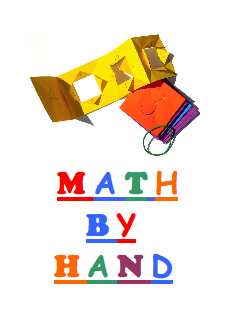
Day 20
For one year, 365 days, this blog will address the Common Core Standards from the perspective of creating an alternate, ambient learning environment for math. Ambient is defined as “existing or present on all sides, an all-encompassing atmosphere.” And ambient music is defined as: “Quiet and relaxing with melodies that repeat many times.”
Why ambient? A math teaching style that’s whole and all encompassing, with themes that repeat many times through the years, is most likely to be effective and successful. Today’s blog will focus on a day in a typical Waldorf Kindergarten.
Free play is paramount here, and is attended to immediately upon entering the room. Pretend is the order of the day, as play acting is the work of the young child, the dress rehearsal for life. Many scenes are enacted, complete with props: flowing silk cloths, wooden playstands with chunky clips to hold the house “walls” up, tree branch building blocks, and whatever raw materials might be needed to add detail to a variety of created worlds.
The Kindergarten teacher is the nexus of this busy scene. As the children play around her, she works at homemaking, performing the typical tasks of a busy mother. Many children may be eager to help, as they gather around her to assist with the washing up, sweeping, polishing, chopping vegetables, sewing, cooking, baking, and more. Whether working or playing, the children are engaged, purposeful, and happily occupied.
After a couple hours it’s clean-up time, and all work and play things are neatly put away in their places by the children and teacher alike. Bathrooms are used and hands are washed in preparation for circle-time. Singing, dancing, hopping, skipping, galloping, jumping, accompany seasonal songs and verses. Play acting follows, the farmer tending his fields, the woodcutter filling her shed against the winter cold.
The circle ends, and all hungrily gather around the table for snack. Warm, fresh-baked rolls or bread, fresh fruit and such are passed around for all to share. A blessing is said and the nutritious meal is eaten, accompanied by lively conversation. The talk turns to what might be waiting outdoors, for fun and games, as places are cleared and the washing up is done.
Outdoor clothes, boots, and hats (or rain-gear if needed) are put on, and the children eagerly bustle through the door to play and work. The outdoors offers many opportunities to be busily creative: digging, climbing, building, and collecting nature’s treasures. Joyful running, working, laughing, and playing continue for an hour or so.
To close the day, the children return to the room and gather around the teacher as she tells a fairy tale. She uses words with intonation, gesture, and movement to tell the tale. Most often, the same story is told every day for a week or two, to the children’s lasting interest and delight.
Weekly activities such as baking, beeswax, watercolor painting, and handcrafts are woven into the day as well. Seasonal field trips and special events are welcomed, with celebration. And beneath all the work and play, runs a current of learning: language arts through story, verse, and song as well as daily conversation, and numerous social and emotional skills. Creativity, imagination, and initiative are all nurtured in the natural course of every day.
You can see how well this format fits a typical homeschool environment! Very little adaptation is needed by a family making home school and school home. A Waldorf classroom mixed with a one-room schoolhouse fits the picture very well.
Tomorrow’s blog will focus on a summary of the Kindergarten Common Core Math Standards and the ambient, alternative activities suggested in this blog. How to gently integrate this work into a day like the one described above will be discussed as well.
Knowledge ensues in an environment dedicated to imaginative, creative knowing, where student and teacher alike surrender to the ensuing of that knowledge as a worthy goal. More Kindergarten tomorrow!
Tags:

Day 19
For one year, 365 days, this blog will address the Common Core Standards from the perspective of creating an alternate, ambient learning environment for math. Ambient is defined as “existing or present on all sides, an all-encompassing atmosphere.” And ambient music is defined as: “Quiet and relaxing with melodies that repeat many times.”
Why ambient? A math teaching style that’s whole and all encompassing, with themes that repeat many times through the years, is most likely to be effective and successful. Today’s blog will focus on Kindergarten Standards 5 and 6, in Geometry. Note that the Common Core Standards will appear in blue, followed by an ambient translation.
Geometry
Identify and describe shapes (squares, circles, triangles, rectangles, hexagons, cubes, cones, cylinders, and spheres).
5. Model and draw shapes, building them from components (e.g., sticks and clay balls).
6. Compose simple shapes to form larger shapes. For example, “Can you join these two triangles with full sides touching to make a rectangle?”
Sticks and clay balls. Build shapes with straight sticks, perhaps making a mobile with three or four different shapes. Take four sticks of even length, overlap the ends and lash them with colorful yarn to create a square. Do the same with 3 sticks for the triangle. A willow wand bent round will make the circle.
Here’s something special for the hexagon. With a long piece of bulky yarn, tie three sticks of equal length together in the middle, then pull them apart so they form an “X” with a line through it. Stabilize the six points by weaving the yarn around each stick in turn, tightening it as you go. As soon as the form is stable, hand it off and have your child(ren) complete it (with help if needed). You could hang these six-sided god’s eyes in a window when finished.
Use yesterday’s cardboard tube “cookie cutters” to create shapes with homemade clay (see below for a recipe). Roll out the clay to a 1/2″ thickness and cut out several of each shape. Hardwood dowels, 1″ X 6″ make fine rolling pins for little hands. When dry, the shapes can be put together to form other shapes. The clay can also be used to create cones, cylinders, and cubes that can be transformed with added simple details into familiar animals or objects.
For the drawings portion, you may want to do some potato printmaking. Cut two very large potatoes in half the short way. Make a 1/2″ thick stamp on the open end for each: circle, square, triangle, hexagon. Have the child(ren) make prints using poster paint or watercolor.
Knowledge ensues in an environment dedicated to imaginative, creative knowing, where student and teacher alike surrender to the ensuing of that knowledge as a worthy goal. More Kindergarten tomorrow!

Tags:
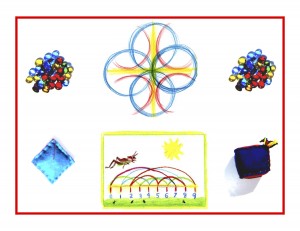
Day 18
For one year, 365 days, this blog will address the Common Core Standards from the perspective of creating an alternate, ambient learning environment for math. Ambient is defined as “existing or present on all sides, an all-encompassing atmosphere.” And ambient music is defined as: “Quiet and relaxing with melodies that repeat many times.”
Why ambient? A math teaching style that’s whole and all encompassing, with themes that repeat many times through the years, is most likely to be effective and successful. Today’s blog will focus on Kindergarten Standard 4, in Geometry. Note that the Common Core Standards will appear in blue, followed by an ambient translation.
Geometry K.G
Analyze, compare, create, and compose shapes.
4. Analyze and compare two- and three-dimensional shapes, in different sizes and orientations, using informatl language to describe their similarities, differences, parts (e.g., number of sides and vertices/”corners”) and other attributes (e.g., having sides of equal length).
To compare, use the sandpaper shapes and their wooden counterparts (see Day 16). For example, if a wooden circle is placed on the sandpaper square, the differences can be easily felt (this can/should be largely experiential at this point). Curved vs. straight, four sharp corners vs. a continuous round line, equal sides with stops and starts vs. no sides, no stops and starts. Plant the idea and watch it happen again and again in the math play corner.
Draw the shapes on the floor or ground with chunky chalk and walk or run them with the child(ren). A running commentary can accompany this. Say or sing, “Around and around and around, a circle!” Or “Walk-stop-walk-stop-walk-stop-walk-stop, a square!” And so on.
Along the same lines, use short, sturdy sticks as pegs to stick into the ground (grass is nice for this activity). Have a ball of chunky yarn or soft rope on hand and tie an end to the first peg. Then have the children trace the outline of the shape. (You will need to place the pegs very close together for the circle.)
Make “cookie cutters” to use as stencils with paint or an inked stamp pad. Cardboard tubes (toilet paper or paper towel tubes work) can be cut in strips and formed into shapes: as is for the circle, pinch 4 corners and straighten the sides for the square, pinch 3 corners and straighten the sides for the triangle, and the same with 6 corners for the hexagon (if you’re feeling ambitious). Staple a half circle strip across the top to use as a handle, then stamp the shapes!
Now for the three-dimensionals. A large exercise ball will do for the sphere and a cardboard box for the cube. The cylinder and cone can be made large and colorful with poster board and tape: a rectangle for the cylinder and a triangle with a rounded bottom for the cone. You may want to double their thicknesses with glue or double-sided tape to make them more sturdy so the child(ren) can explore the shapes on a grand scale.
Here’s a fun project: sew cloth three-dimensionals. They can be large or small, and used for toss and catch games. A rectangle with two circles on the top and bottom for the cylinder, a triangle with a curved bottom and a circle base makes the cone, and you’ll find a pattern below for the sphere (from instructions for the Math By Hand Comet Ball). Use either 4 or 6 of the “eye” sections. Toss the shapes!
Knowledge ensues in an environment dedicated to imaginative, creative knowing, where student and teacher alike surrender to the ensuing of that knowledge as a worthy goal. More Kindergarten tomorrow!
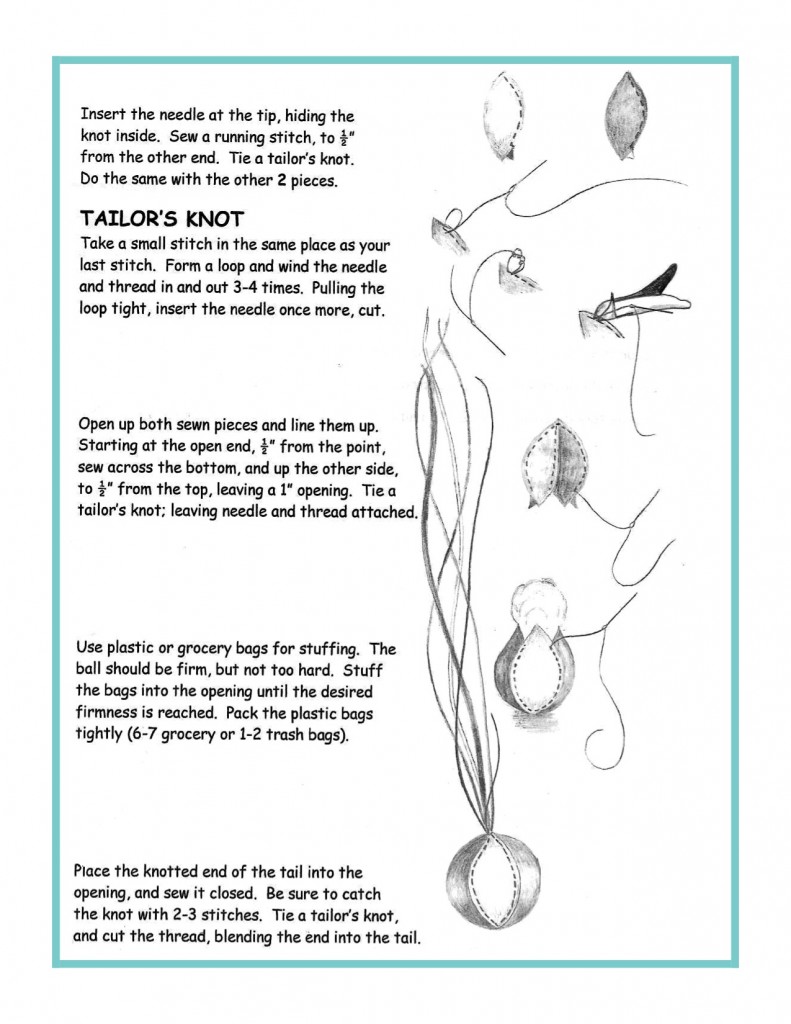
Tags:
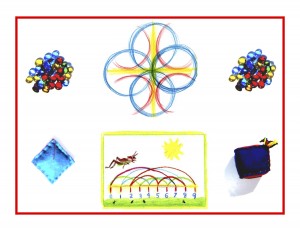
Day 17
For one year, 365 days, this blog will address the Common Core Standards from the perspective of creating an alternate, ambient learning environment for math. Ambient is defined as “existing or present on all sides, an all-encompassing atmosphere.” And ambient music is defined as: “Quiet and relaxing with melodies that repeat many times.”
Why ambient? A math teaching style that’s whole and all encompassing, with themes that repeat many times through the years, is most likely to be effective and successful. Today’s blog will focus on Kindergarten Standards 2 and 3, in Geometry. Note that the Common Core Standards will appear in blue, followed by an ambient translation.
Geometry K.G
Identify and describe shapes (squares, circles, triangles, rectangles, hexagons, cubes, cones, cylinders, and spheres).
2. Correctly name shapes regardless of their orientations or overall size.
3. Identify shapes as two-dimensional (lying in a plane, flat) or three-dimensional (solid).
First, a catch-up on yesterday’s blog. The rectangle won’t be introduced yet since its shape is so similar to the square. A bit later for that, but you could show the hexagon and hexagram by comparing them to honeycombs and snowflakes, respectively. See the bottom picture for a quick way to make both.
Cut at least 12 hexagons out of gold felt. After you tell a simple story about bees and honey, and perhaps do a bee finger-play verse or song, show the child(ren) how to connect the hexagons while singing a simple song about bees filling their pots with honey. Extended play with the hexagons over time will impart a feeling for the hexagon shape.
Cut a number of hexagrams out of white paper. Tell a simple story about how every snowflake is different, and/or do a snowflake finger-play verse or song. Refold the hexagrams and cut various designs into them to make snowflakes. You could later have the child(ren) do the same with some you’ve cut out of much larger paper, using blunt scissors.
Now for today’s standards. Once the shapes are pretty well known, through yesterdays sandpaper and pouch activities, mix in different sizes of the same shapes. The larger or smaller sizes could be paired with the sandpaper shapes for matching purposes.
Go back online and find some wooden cubes, cones, cylinders, and spheres. You should be able to find these in sets as well. Mix them in with the flat shapes, then play a close game of catch, gently tossing one at a time. For the flat ones, help the child(ren) to rub hands back and forth over them while saying “flat.” For the solid ones cup your hands under the child’s while saying “solid.” These should be put away and kept only for supervised play, since a hard throw could hurt someone.
Play once again wins the day, as you keep it real with singing, games, and movement. I’ve seen many examples of worksheets meant for learning about shapes. Though they can be cute and catchy, many of them require reading the names of the shapes, which is really too advanced for this age. Overall, they have nothing over real play! Knowledge ensues in an environment dedicated to imaginative, creative knowing, where student and teacher alike surrender to the ensuing of that knowledge as a worthy goal. More Kindergarten tomorrow!
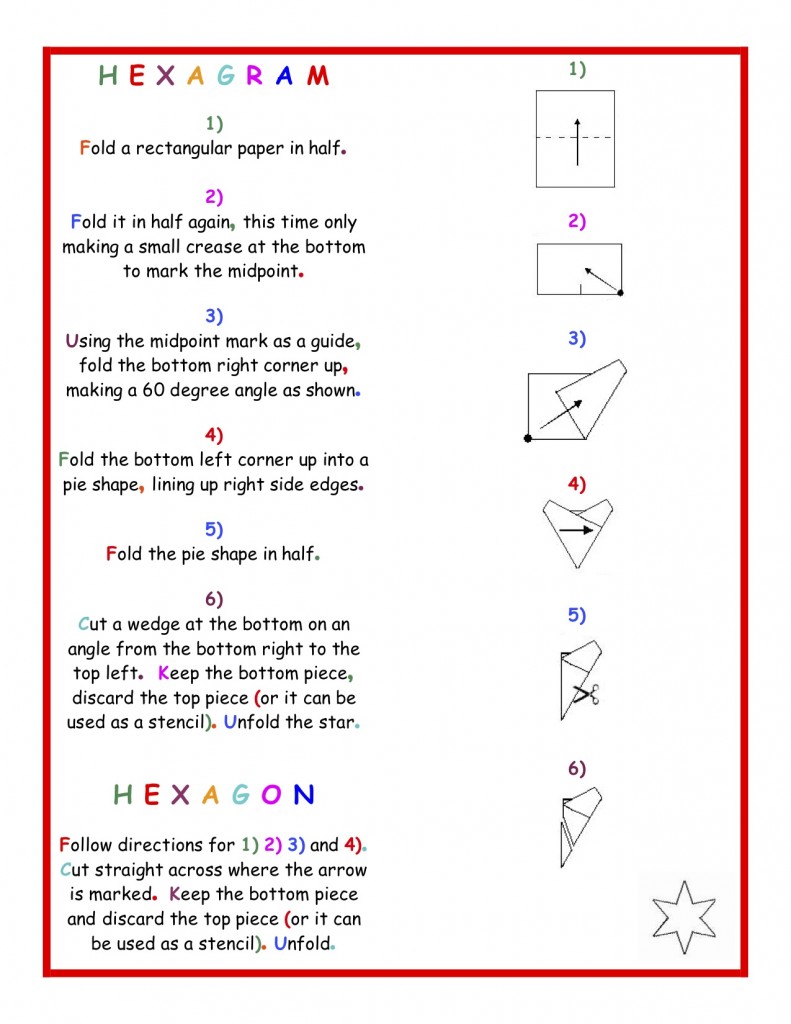
Tags:
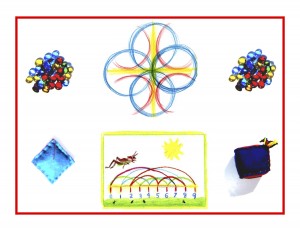
Day 16
For one year, 365 days, this blog will address the Common Core Standards from the perspective of creating an alternate, ambient learning environment for math. Ambient is defined as “existing or present on all sides, an all-encompassing atmosphere.” And ambient music is defined as: “Quiet and relaxing with melodies that repeat many times.”
Why ambient? A math teaching style that’s whole and all encompassing, with themes that repeat many times through the years, is most likely to be effective and successful. Today’s blog will focus on Kindergarten Standard 1, in Geometry. Note that the Common Core Standards will appear in blue, followed by an ambient translation.
Geometry K.G
Identify and describe shapes (squares, circles, triangles, rectangles, hexagons, cubes, cones, cylinders, and spheres).
1. Describe objects in the environment using names of shapes, and describe the relative positions of these objects using terms such as above, below, beside, in front of, behind, and next to.
I’ve not been looking forward to “ambientifying” this set of Common Core standards because they require such abstract, objectifying perceptions and awareness. I searched the net for hands-on activities appropriate to this standard and found quite a few worksheets and plastic shape sorting sets. How to find something warmer and more person-to-personable?
A Montessori approach may be a good place to start. Beginning with the circle, square, rectangle, and triangle, make a template for each one (around 4″ is a good size to start with). Use a cup or plate to trace the circle and either 1″ graph paper (or just a ruler and pencil) to outline the others.
Cut out the shapes and use them as patterns to trace each one onto the back of medium grain sandpaper. Cut out the sandpaper shapes and glue each one onto its own base of mat board, cardboard, or even pieces of flat, smooth wood. Have your child(ren) watch and/or participate in this process as much as possible!
Lay the shapes out on a desk or table top and invite the child(ren) to feel them. Say each shape while guiding hands over them, then add these to the play materials in the math corner. Practice this a lot, and soon the child(ren) will take up further exploring and naming.
Make very large outlines of these same shapes on the floor or ground and have the child(ren) walk around their outsides, while you quietly say (or sing) the name of each shape. When the shapes and names have been absorbed in this sensory way, you can gently ask what shapes can be found all around, in everyday surroundings.
After the shapes are pretty well known, you could play a “guess the shape” game. Fill a cloth drawstring pouch, big enough for exploring hands to fit into, with flat, wooden shapes (you can make or buy these, I found some nice wooden sets online). Have the child(en) reach into the pouch, feel and name the shape, then pull it out to see if it’s correct. Each wooden shape could be placed on top of its sandpaper counterpart for matching purposes.
For the positioning, again a sensory and concrete approach with movement would be best. Place two children, or yourself and a child into these positions and have them mime them as they say each word. Here are a few examples:
1) Above and below: one child crouches on all fours with head down and says “below” in a muffled voice while another child straddles over with arms extended and says “above!” in a more exuberant voice.
2) In front of and behind: one child stands in front with hands on hips and says, “in front of” in a louder tone, and the other puts his hands on the other’s shoulders and says, “behind” in a softer tone.
3) Beside: the two stand with their arms around each other’s shoulders and say, “beside” together.
After these concepts have been absorbed, say the words while placing objects in each of the positions. Knowledge ensues in an environment dedicated to imaginative, creative knowing, where student and teacher alike surrender to the ensuing of that knowledge as a worthy goal. More Kindergarten tomorrow!
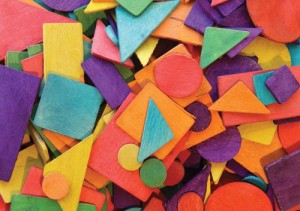
Tags:
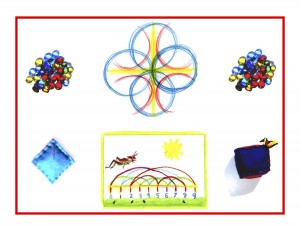
Day 15
For one year, 365 days, this blog will address the Common Core Standards from the perspective of creating an alternate, ambient learning environment for math. Ambient is defined as “existing or present on all sides, an all-encompassing atmosphere.” And ambient music is defined as: “Quiet and relaxing with melodies that repeat many times.”
Why ambient? A math teaching style that’s whole and all encompassing, with themes that repeat many times through the years, is most likely to be effective and successful. Today’s blog will focus on Kindergarten Standard 3, in Measurement and Data. Note that the Common Core Standards will appear in blue, followed by an ambient translation.
Measurement and Data K.MD
Describe and compare measurable attributes.
3. Classify objects into given categories; count the numbers of objects in each category and sort the categories by count.
If we believe that early childhood should be filled with wonder and imaginative play, the traditional 3 R’s (reading, ‘riting, ‘rithmetic) may not have a place in the Kindergarten. We could substitute these 3 R’s: rhythm, repetition, reverence. Children do better with rhythm as a staple of their days and nights, and the child before age 7 is especially in need of it.
Regular mealtimes and bedtimes are only part of the picture. The young child thrives in a predictable environment. Sameness is not boring here, and repetition is key. Waldorf Kindergartens adhere to a schedule that’s reminiscent of the nursery rhyme/song that goes, “Monday’s the day we wash our clothes . . .” Each day of the week has its special focus: Monday might be soup day, and Tuesday bread day, etc.
The content of morning circle and story time are also rhythmically repetitive. The morning circle consists of the same songs, verses, and movement for two weeks, so they can be thoroughly learned by heart. And the same fairy tale is told for those two weeks as well. In the Kindergarten, stories never lose their magic, but become more so every time they’re told.
Reverence is apparent in the way the children are held: in sacred trust. Trust that this is right for them, against all odds of academic pushing down to younger and younger ages. Rudolf Steiner said, “Receive the child in reverence, educate her with love, and let him go forth in freedom.” A truly free education must first and foremost respect and revere the kingdom of childhood.
When any teaching is connected to something else, like a story, a picture, movement, or nature, for example, it fits the child. S/he gets it. But more importantly, it pieces the modern world back together to wholeness. The fabric of life is not ripped up into abstract standards and learning outcomes, but is a healthy, nurturing part of life.
On to today’s standard. This could easily be done using your and your child(ren)’s nature collections. Children naturally love to sort, categorize and make order out of chaos. Have them do just that with several collections by mixing the contents of some of your baskets (i.e., acorns, shells, and stones) and providing 3 empty baskets for sorting. If you vary the number of each, the different amounts will very naturally be apparent.
You could take this a step further and make a connection with a story. Many fairy tales have this common plot: three siblings go out into the world and one of them (usually the youngest) is considered foolish and silly, not able to make his/her way in the world. S/he is also usually fond and protective of the creatures encountered on their journey. The siblings are tested, and often the test involves sorting, counting, or otherwise being aware of numerous objects. This lesson could be tied in to the sorting and counting aspect of a story.
In any case, keep it low key and play oriented. A math corner could be set up with materials that encourage this sort of purposeful play. Knowledge ensues in an environment dedicated to imaginative, creative knowing, where student and teacher alike surrender to the ensuing of that knowledge as a worthy goal. More Kindergarten tomorrow!
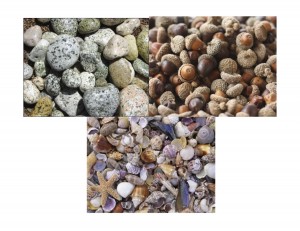
Tags:
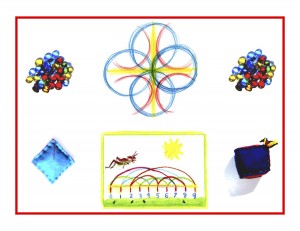
Day 14
Two weeks! Nice to be able to measure this blogtime in weeks. Still standing at the bottom of the mountain looking up at that far-off peak, but the magic is in the journey. Hasn’t more than one sage said that the journey of a thousand miles begins with a single step?
It’s true that once an endeavor is begun, no matter how daunting, the view from the inside and “doing it” is easier than all of the anticipation. So don’t be afraid to get your feet wet or your hands dirty: go ahead and take the plunge, by striving for an education for your child(ren) that’s warm, sensible, fun, effective, (and not standardized).
For one year, 365 days, this blog will address the Common Core Standards from the perspective of creating an alternate, ambient learning environment for math. Ambient is defined as “existing or present on all sides, an all-encompassing atmosphere.” And ambient music is defined as: “Quiet and relaxing with melodies that repeat many times.”
Why ambient? A math teaching style that’s whole and all encompassing, with themes that repeat many times through the years, is most likely to be effective and successful. Today’s blog will focus on Kindergarten Standard 2, in Measurement and Data. Note that the Common Core Standards will appear in blue, followed by an ambient translation.
Measurement and Data K.MD
Describe and compare measurable attributes.
2. Directly compare two objects with a measurable attribute in common, to see which object has “more of”/”less of” the attribute, and describe the difference. For example, directly compare the heights of two children and describe one child as taller/shorter.
Cooking! And other food experiences are the perfect venue for working with this standard. In the kitchen or out in the garden, many opportunities arise for making these sort of observations. Stages of veggie growth, differences in the same foods’ taste, texture, or temperature depending on how it’s cooked, prepared, or served, are just a couple examples.
Cooking and eating yesterday’s stone soup for example. would be a wonderful way to make these observations and comparisons. Two of the staples in the Waldorf Kindergarten are food preparation and community meals, as breakfast and lunch are prepared and enjoyed every day. In these rushed and hectic times, it’s challenging to focus on the homely arts.
One of the great advantages of homeschooling is that it is so anchored in the daily life of the home. John Dewey’s philosophy of education revolved around experience, or setting teaching in an environment that immerses itself in life. This is so often precluded in the classroom because it doesn’t fit into a standardized curriculum.
Math is very comfortable with cooking! You really don’t need to set up formal lessons in measurement, just have your little ones at your elbow and helping whenever they can, as you prepare the family meals. Knowledge ensues in an environment dedicated to imaginative, creative knowing, where student and teacher alike surrender to the ensuing of that knowledge as a worthy goal. More Kindergarten tomorrow!
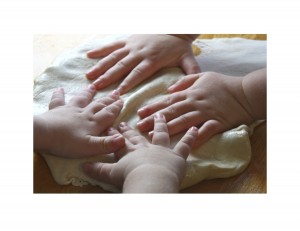
Tags:
Day 12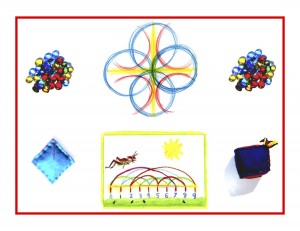
For one year, 365 days, this blog will address the Common Core Standards from the perspective of creating an alternate, ambient learning environment for math. Ambient is defined as “existing or present on all sides, an all-encompassing atmosphere.” And ambient music is defined as: “Quiet and relaxing with melodies that repeat many times.”
Why ambient? A math teaching style that’s whole and all encompassing, with themes that repeat many times through the years, is most likely to be effective and successful. Today’s blog will focus on Kindergarten Standard 1, in Number and Operations in Base Ten. Note that the Common Core Standards will appear in blue, followed by an ambient translation.
Work with numbers 11-19 to gain foundations for place value.
1. Compose and decompose numbers from 11 to 19 into ten ones and some further ones, e.g., by using objects or drawings, and record each composition or decomposition by a drawing or equation (e.g., 10 + 8 = 18; understand that these numbers are composed of ten ones and one, two, three, four, five, six, seven, eight, or nine ones.
Foundational yes, but not yet explicit. Most of the Kindergarten day should be devoted to play. I say “devoted” quite consciously, meaning there’s a nimbus of devoted reverence around the work of play. Be sure to give it its due.
I have a small picture on my desk of my daughter at 2, her first school picture. Though I was a stay-home mom, we thought the enrichment of having two mornings a week at a nursery school would be good. But her face in this picture is so sad, with eyes that seem to be begging to not be in school so soon.
More and more research findings are showing that unstructured play until age 7 is best. Do encourage play with numbers! You might consider having a math corner, where the child(ren) can play freely with the materials you’ve introduced. Low-key guidance is also helpful and welcome here, ideally seamlessly blending learning and play.
For this concept (place value through composing and decomposing numbers from 1-19) the glass jars and beans introduced on Day 4 will do nicely. Here is an excerpt from that post.
The Math By Hand system uses beans for value coding ones, tens, and hundreds to teach place value in second grade. Black beans are ones, kidney beans are tens, and lima beans are hundreds. Without becoming too abstract, it may be possible to teach this standard’s concept using the beans.
You’ll need black beans, kidney beans, and 20 small glass jars or clear plastic containers. For the first 10 jars, place 1 black bean in jar one, 2 in jar two, and so on up to 9 in jar nine. Place 1 kidney bean in jar ten, 1 kidney and 1 black bean in jar eleven, and so on up to jar nineteen. Place 2 kidney beans in jar twenty.
No need to label the jars with their numbers, since the number of beans inside says which number each jar represents. This builds a wonderful foundation for understanding place value as well, without becoming too abstract. The jars demonstrate the concept, but composing and decomposing the numbers will need something different.
A story would be nice here. Again borrowing from Beatrix Potter (who famously said that school would have hampered her storytelling talents) Squirrel Nutkin could help us with this concept. For the story props you’ll need 20 or so acorns and a closed cardboard tube. Cut a 2″ diameter hole in the middle of the tube and cover the surface. Glue actual tree bark to the tube or have the child(ren) color a piece of drawing paper with brown crayon for bark.
Squirrel Nutkin’s tree could hold 10 acorns. Say, “Squirrel Nutkin had gathered 10 acorns into his tree, but he needed more for the long winter ahead. He was only able to find 1 more the next day, but wanted to wait until he had 19 before he added the new acorns to his store.” Then you could put different numbers of acorns next to the tree and ask how many does that number plus 10 equal.
Do a guided drawing with the child(ren), showing the 10 acorns inside the tree plus different numbered piles of acorns next to it. Have the child(ren) count out loud as they draw each group, saying “1, 2, 3, etc.” After the drawings are done and circled, count the acorns differently as the stems are added to the acorns: “1-10 then 11, 12, 13, etc.” No need to write the equations at this point, counting out loud should be enough.
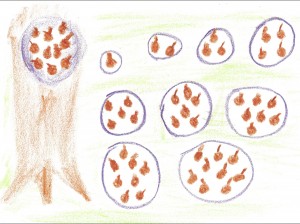
Knowledge ensues in an environment dedicated to imaginative, creative knowing, where student and teacher alike surrender to the ensuing of that knowledge as a worthy goal. More Kindergarten tomorrow!
Tags:
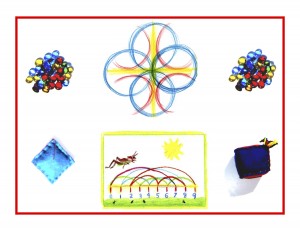
Day 11
For one year, 365 days, this blog will address the Common Core Standards from the perspective of creating an alternate, ambient learning environment for math. Ambient is defined as “existing or present on all sides, an all-encompassing atmosphere.” And ambient music is defined as: “Quiet and relaxing with melodies that repeat many times.”
Why ambient? A math teaching style that’s whole and all encompassing, with themes that repeat many times through the years, is most likely to be effective and successful. Today’s blog will focus on Kindergarten Standard 5, in Operations and Algebraic Thinking. Note that the Common Core Standards will appear in blue, followed by an ambient translation.
5. Fluently add and subtract within 5.
First, a word about testing for Common Core Standards. It is my understanding that formal testing does not begin until Grade 3, but that teachers are encouraged/required to apply benchmarks and assessments regularly, (quarterly for each standard) starting in Kindergarten.
The assessment/testing expectation for Kindergarten is that a rigorous foundation upon which further math knowledge and skills can be added is being laid. But if teaching and learning is to reflect the qualities, beauty, and wholeness of math, then it must be three dimensional at all times: including the head, heart, and hands. And it needs to be deeply interwoven with life and direct experience.
The assessment branch of the Common Core is PARCC: Partnership for Assessment of Readiness for College and Careers. In the PARCC Model Content Frameworks for Mathematics / Version 3.0 – November 2012, “fluency” is described as:
“Wherever the word fluently appears in a content standard, the word means quickly and accurately. It means more or less the same as when someone is said to be fluent in a foreign language. To be fluent is to flow: Fluent isn’t halting, stumbling, or reversing oneself. A key aspect of fluency in this sense is that it is not something that happens all at once in a single grade but requires attention to student understanding along the way. It is important to ensure that sufficient practice and extra support are provided at each grade to allow all students to meet the standards that call explicitly for fluency.”
In that light, we could say that slow learning goes deepest, and that if the predisposition of the child up to age 7 is taken into account, abstract learning has no place in the Kindergarten. So, how to best insure that your Kindergartner(s) can fluently add and subtract within 5?
Using objects to effectively see the quantities is essential. Here’s how to proceed: place 5 objects (acorns, small stones, shells, etc.) on a flat surface and lay your hand over them, saying, “Five.” Have the child(ren) do the same. Move 2 objects to the side and say, “Take away 2,” laying your hand over the 2. Have the child(ren) do the same. Then place your hand over the 3 objects and say, “Is 3.” Have the child(ren) do the same.
After exploring all possible combinations in subtraction, move on to addition using the word “and” in place of “take away.” Again, the Kindergartner’s inclination toward imitation will assure that this task is repeatedly practiced, with little prompting from you.
Later, after fluency with objects is attained, you could have the child(ren) translate this into writing by using lines up to 5 to represent the numbers. Now would be a good time to introduce some of the 4 processes signs. Here’s a way to do that:
Hold your hands in front of you in fists with the index fingers pointing in the opposite directions. Say that the “is” sign points to both numbers to show that they are the same. You could start out attaching little arrows to the end of both lines for better understanding of the concept.
For the plus and minus signs you could say that the “take away” sign is empty “-” and the “and” sign is full “+” (just as a visual aid). Then have the child(ren) represent the equations like this: l l l l l – l l = l l l or l l + l l = l l l l.
Knowledge ensues in an environment dedicated to imaginative, creative knowing, where student and teacher alike surrender to the ensuing of that knowledge as a worthy goal. More Kindergarten tomorrow!
Tags:
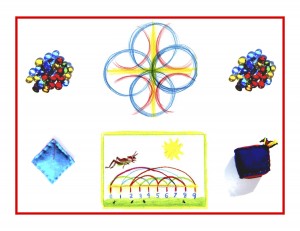
Day 10
Yay . . . double digits! The old image had to go because Facebook will not promote a post that contains more than 20% text (letters or numbers). The new image includes several Math By Hand features: glass counting gems, a second grade form drawing, beanbags, and a fable-inspired times tables pattern.
For one year, 365 days, this blog will address the Common Core Standards from the perspective of creating an alternate, ambient learning environment for math. Ambient is defined as “existing or present on all sides, an all-encompassing atmosphere.” And ambient music is defined as: “Quiet and relaxing with melodies that repeat many times.”
Why ambient? A math teaching style that’s whole and all encompassing, with themes that repeat many times through the years, is most likely to be effective and successful. Today’s blog will focus on Kindergarten Standard 4, in Operations and Algebraic Thinking. Note that the Common Core Standards will appear in blue, followed by an ambient translation.
4. For any number from 1 to 9, find the number that makes 10 when added to the given number, e.g., by using objects or drawings, and recvord the answer with a drawing or equation.
The numbers will be shown with knots today. You’ll need to have several lengths of thick rope or strips of soft fabric like thin cotton or silk on hand. First, a knot-tying lesson. A picture is worth a thousand words, and this is most especially true for a young child. So, teach tying a simple overhand knot (it looks like a pretzel) with this story.
“Peter Rabbit was so hungry for Mr McGregor’s lettuces, cabbages, and carrots that he didn’t think about how he was caught last time. He looked for a hole in the fence.” (Create the fence hole by placing the end over the rope). “Then he stuck his quivering rabbit nose right through the hole and dashed into the garden!” (Insert the end through the hole and pull).
You’ll need a long rope or fabric strip and several shorter ones. Start by tying 10 knots in the long rope or strip and say, “Peter Rabbit found 10 holes in the garden fence and then Mr. McGregor had to fix them.” (Show the rope with 10 knots.)
“But Peter Rabbit wanted those carrots so badly that he made or found more and more holes. Mr. McGregor was so busy tending the garden that he always waited until there were 10 holes before he fixed them all again. If Peter found 1 hole today, how many more until Mr. McGregor fixed all 10 of them?”
Cover the 1 knot with a cloth and count the remaining 9 with the child(ren). Repeat this with the other combinations that total 10. Have the child(ren) touch the knots as they count them. Afterwards, the child(ren) can tie more knots in the smaller pieces of rope, counting as they tie them. The tying itself is a wonderful way to enhance dexterity, eye-hand coordination, and small motor skills.
Do a very simple crayon drawing with the child(ren) to illustrate this activity. Knowledge ensues in an environment dedicated to imaginative, creative knowing, where student and teacher alike surrender to the ensuing of that knowledge as a worthy goal. More Kindergarten tomorrow!

Tags:

